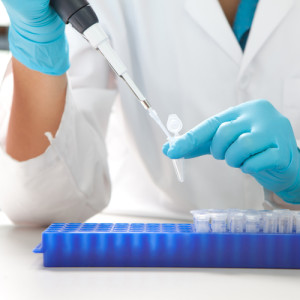
Depending on the desired characteristics of the stable cell line, we provide the following assays:
QRT-PCR
For cell lines that are intended for the production of shRNA to induce RNAi effects, the quantity of RNAi-inducing species can be measured via Real Time quantitative Reverse Transcriptase Polymerase Chain Reaction (qRT-PCR). This technique is well-established as the most sensitive measurement of gene expression, allowing both a quantitative and a qualitative measurement of the RNAi gene silencing results.
In qRT-PCR, a reverse transcriptase enzyme is used to convert the RNA template gets converted into a complementary DNA (cDNA) molecule. A polymerase chain reaction (PCR) is then used to amplify the cDNA, and then the cDNA is measured.
WESTERN BLOTTING
For cell lines intended for production of specific proteins, a Western blot is utilized to quantify the quality of the expressing cell line. This common technique utilizes antibodies that bind to a specific protein to quantify that species. In addition, for shRNA effects, the Western blot can be used to measure the amount of gene repression, allowing evaluation of each cell line for effectiveness.
The Western blot is an assay intended to detect a single protein in a mixture of proteins. It requires an antibody specific to the protein that is intended to be detected. The Western blot involves three steps. First, proteins are separated by size via gel electrophoresis. The gel electrophoresis bands are then transferred to a membrane or solid support. Subsequently, the membrane then is incubated with antibodies specific to the target protein, which are linked to an imaging molecule (either via fluorescence or a colorimetric enzymatic tag). Proteins that have not bound to the antibodies are washed off, and the film is developed to determine the amount and size of proteins that bound with the antibodies.
WES
In addition to the standard Western blot described above, we offer analysis of protein expression using ProteinSimple’s Wes Simple Western blotting system. This highly sensitive automated Western blotting system can run 25 samples simultaneously, utilizing a novel capillary system. It can detect protein at the nanogram level in nanoliter-volume samples, decreasing the sample size required for quality control. In addition, its three-hour run time allows us to have same-day verification of protein expression. Use of the Wes allows us to provide exceptional quality control for our protein expression cell lines.
ELISA
In addition to Western blotting, enzyme-linked immunosorbent assays (ELISAs) are used to quantify antibody or antigen binding activity. These assays can measure antibody or antigen binding activity, either in a pure solution of a single protein, or in a mixed solution of multiple proteins such as serum. ELISAs perform this measurement via conversion of the binding activity of an antibody or antigen to a measurable spectrophotometric signal. ELISAs are a common assay in industrial and research applications, especially in diagnostics and quality control. This technique was first introduced in the 1970s to replace the use of radioactive isotopes in protein detection.
The ELISA technique leverages the specificity of antibodies in the detection of protein. More specifically, an enzyme is covalently linked with a target-specific antibody (either polyclonal or more reliable monoclonal antibodies). In the presence of the corresponding antigen, the antibody-enzyme is bound, any unbound antibody-enzyme complexes are removed via a washing step, and a substrate which reacts with the enzyme to produce a colored product is introduced in order to measure the antibody-antigen binding. ELISAs are typically performed in a 96-well plate and are sufficiently sensitive to detect a nanogram or less of a target antigen. Two common ELISA types used are indirect ELISA and sandwich ELISA.
INDIRECT ELISA
An indirect ELISA is utilized in the detection of antibodies. These ELISAs are performed by first coating a surface with a known amount of antigen, and then a solution with an unknown quantity of antibody (possibly patient serum) is added to the well in order to bind it to the antigen. Detection is performed with the addition of enzyme-linked antibodies (chosen due to their specificity for the antibody being measured), which are allowed to bind, and unbound antibodies are removed by washing. Substrate is added to induce coloration in the enzyme, indicating the presence of the target antibody. One application of this type of ELISA is in the test for HIV infection.
SANDWICH ELISA
Sandwich ELISAs are used to detect and quantify a particular antigen, even in small quantities. An antibody specific to the antigen being measured is coated on the bottom of a well. The solution containing the antigen is added to the well and allowed to bind to the antigen. A second, different antibody that also binds the target antigen and has an enzyme linked to it is added to the well, allowed to bind, and then excess antibody is washed off. The addition of substrate causes the presence of coloration measured by spectrophotometry, and the extent of reaction is proportional to the quantity of antigen present.
REPORTER ASSAYS
Development of stable cell lines often uses reporter assays to determine the presence of the desired traits in each cell line. Possible assays include antibiotic resistance, luciferase production, green fluorescent protein (GFP) production, and red fluorescent protein. These assays couple the expression of the desired gene with the expression of a gene that is easily detected via visual means or antibiotic solution, allowing for near-instant detection of expression.
REQUEST A FORMAL SERVICE QUOTE:
- Development of Stably Expressing Cell Line
- Stable RNAi Cell Line Development: shRNA Gene Knockdown
- Protein overexpression: Mammalian stable cell line development
- Generation of Stable Cell Line in 28 Days
BIOLOGICAL RESEARCH SERVICES | SCIENCE OF STABLE CELL LINE GENERATION | IN THE CLINIC AND LABORATORY | IN-HOUSE QUALITY CONTROL | COMPREHENSIVE CELL LINE DEVELOPMENT